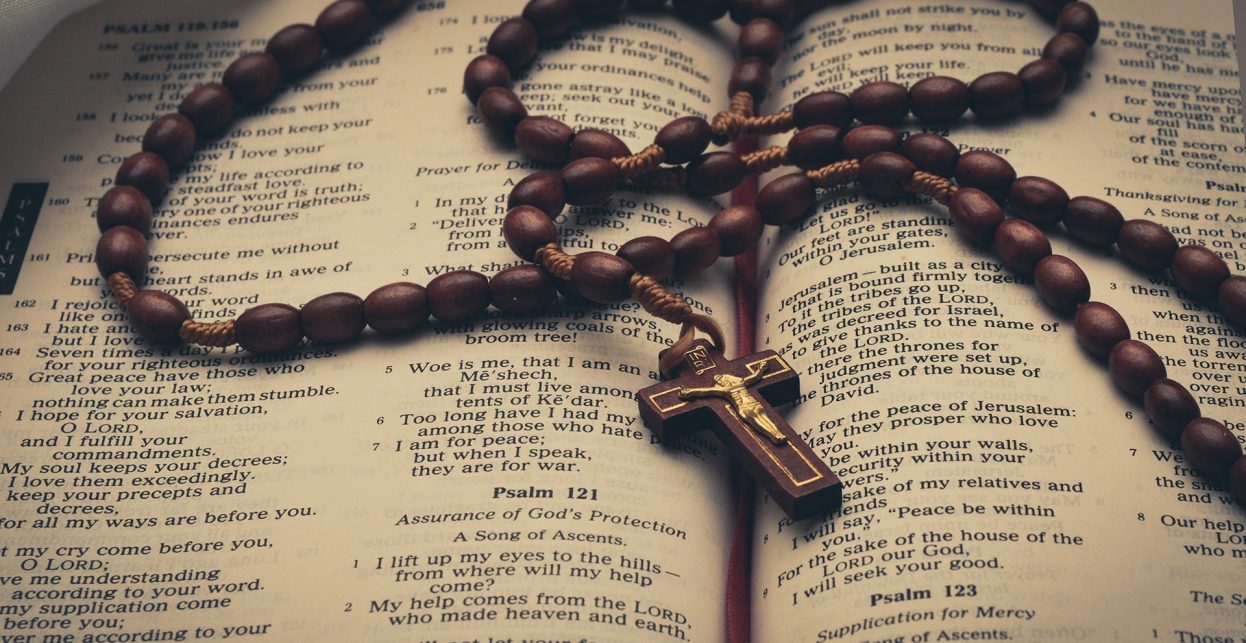In Catholicism, the mysteries of the rosary allow members of the church to meditate and have a deeper appreciation of the life of the Virgin Mary and her Son, Jesus Christ.
According to the Catechism of the Catholic Church, meditation during prayer engages one’s imaginations, desires, thoughts, and emotions.
As such, the mysteries of the rosary are essential for the Catholic Church and its members.
In the Catholic Church, the term rosary refers to a string/cord with a set of beads and the prayers said using the beads.
Understanding the Holy Rosary
The name “Rosary” is derived from the Latin word rosarium, which translates to a garden/garland of roses.
This name is consistent with the Marian apparitions of the Blessed Virgin in which she performed the Miracle of the Roses.
The rosary consists of well-arranged beads that can be used when counting prayers. There are up to five sets of beads that correspond to different prayers in Catholicism.
Catholicism teaches that the mysteries of the rosary help members of the church to learn more about the nature of Jesus Christ and His mother, Mary.
To get a better understanding of the mysteries of the rosary, however, there are basic things that you need to know about the Catholic Church and the Rosary itself.
The Mysteries of the Rosary: History of the Rosary
The Rosary has a long history that can be traced back to pre-Christian times. Religious historical records show that monks from the middle ages used a string of beads when reciting certain prayers.
However, the rosary gained popularity in Catholicism in the early 13th century when St. Dominic claimed that the Virgin Mary had appeared to him.
St. Dominic purported that the Blessed Mother instructed him to teach members of the church about the Rosary and its importance.
As a result, St. Dominic used the Rosary during his missionary travels. Nonetheless, some scholars have rejected these claims because certain parts of the history of the Rosary predate St. Dominic.
Despite this, the use of the Rosary spread throughout Christianity, with Catholicism being at the forefront.
The Rosary became even more popular during the 15th century when the Holy League came out victorious at the Battle of Lepanto, which took place in 1571.
It is believed that Pope Pius V encouraged the Christian fleet to say the Rosary as they were going to battle. This story won the hearts of many Christians because the fleet of the Ottoman Empire outnumbered that of the Holy League in every way.
Consequently, many people believed that the Blessed Mother had interceded on their behalf, thus leading to their miraculous victory.
The establishment of the month of the Holy Rosary by Pope Pius V also played a crucial role in promoting the use of the Rosary during prayer.
Significance of the Mysteries of the Rosary in Catholicism
 As stated earlier, the Rosary is both a prayer and a string of beads that is used by the adherents of the Catholic Church to aid in meditation.
As stated earlier, the Rosary is both a prayer and a string of beads that is used by the adherents of the Catholic Church to aid in meditation.
The Rosary is not only one of the most cherished prayers in Catholicism but also has great spiritual significance to members of the church.
Catholics say the Rosary by repeatedly reciting a set of scripture-based prayers that are connected to the mysteries. Through this, the one offering the prayer can enter into a contemplative state.
The original Rosary only had 3 sets of mysteries. Each set was made up of five components, thereby bringing the number of mysteries to 15.
However, the number has since been increased to 20 mysteries after Pope John Paul II added a new set with five additional components in October 2002.
Each mystery focuses on special events that can help the adherents of Catholicism to cultivate strong faith in God, Jesus Christ, Holy Spirit, Virgin Mary, and the Saints.
Like most prayers in Catholicism, the Rosary can be said liturgically or in private. The Catholic Church encourages its members to reflect on the mysteries of the rosary on specific days of the week.
The Four Sets of Mysteries of the Rosary
The 20 mysteries of the rosary come from different biblical accounts, but they all have one thing in common, which is to bring all members of the church closer to God.
By meditating on the life of Mary and Jesus Christ through the prayers of the rosary, adherents can build meaningful relationships with God and the Church.
According to Catholic teachings, the four sets of mysteries are unique and special not only to the church but also before God.
There is a way in which the rosary must be recited. As such, members of the church are taught how to say the rosary at an early age.
Converts are also encouraged to learn the rosary since it has great significance to the Catholic Church.
Here are the four sets of mysteries of the Holy Rosary:
1. The Joyful Mysteries
As the name suggests, the events surrounding these mysteries are those of joy and happiness.
The Joyful Mysteries mainly cover the birth of Jesus Christ and the events that led to his existence on earth.
Members of the Catholic Church are encouraged to pray and meditate on the Joyful mysteries on Sundays and Mondays.
Features of the Joyful Mysteries:
- The Annunciation
-Angel Gabriele appears before the Virgin Mary to inform her of the special role that she will play in becoming the mother of Jesus Christ.
- The Visitation of Mary to Elizabeth
-Elizabeth tells Mary that she is indeed blessed, thus confirming angel Gabriel’s message.
- The Birth of Jesus Christ
-Mary gives birth to Jesus Christ in a manger in Bethlehem.
- The Presentation of Jesus Christ
-Jesus is taken to the temple in Jerusalem and is presented before God.
- The Finding of Jesus In The Temple
-Joseph and Mary find 12-year-old Jesus in temple courts discussing matters of faith with the religious teachers.
2. The Mysteries of Light
These are the newly added mysteries as instituted by John Paul II. The Mysteries of Light are centered on the ministry of Jesus Christ.
The events highlighted in the mysteries of light form the basis of most Christian beliefs. John Paul II suggested that the mysteries of light are to be prayed on Thursdays.
Features of the Mysteries of Light:
- The Baptism of Jesus Christ
-During His baptism in the River Jordan, the heavens opened and the spirit of God descended upon Jesus Christ in the form of a dove.
- The Wedding at Cana
-Jesus performs His first miracle by transforming water into wine at the wedding at Cana.
- The Proclamation of the Kingdom of God
-Jesus proclaims the good news about God’s kingdom to all who were willing to listen.
- The Transfiguration
-Jesus Christ transfigures himself before James, John, and Peter. The three could see Him conversing with Elijah and Moses in what seemed like a spiritual realm.
- The Institution of the Eucharist
-The disciples share the Last Supper with Jesus Christ, thereby marking the introduction of the Holy Eucharist.
3. The Sorrowful Mysteries
The events covered under the sorrowful mysteries are those that led to the suffering and death of Jesus Christ.
Catholic adherents pray the sorrowful mysteries on Tuesdays and Fridays.
Features of the Sorrowful Mysteries:
- The Agony of Jesus Christ in the Garden Gethsemane
-Jesus Christ tells His disciples that His soul is overwhelmed with sorrow because He knows He’s going to die.
- The Scourging of Jesus Christ
-Jesus Christ is flogged with whips multiple times.
- Jesus is Crowned with Thorns
-Jesus is crowned the king of the Jews with thorns.
- The Carrying of the Cross
-The son of God is forced to carry the cross that will be used during His crucifixion.
- The Crucifixion
-Jesus Christ is nailed to the cross and dies from his injuries.
4. The Glorious Mysteries
The Glorious Mysteries are centered on the resurrection of Jesus Christ and His ascension into heaven.
Additionally, the mysteries highlight key facts about the coming of the Holy Spirit and the assumption of Mary, the Blessed Mother, into heaven.
The Catholic Church suggests that the Glorious Mysteries are to be prayed on Wednesdays and Sundays.
Features of the Glorious Mysteries:
- The Resurrection
-Jesus Christ is resurrected by God three days after his death.
- The Ascension
-Jesus Christ ascends into heaven in his physical form.
- The Coming of the Holy Spirit at Pentecost
The disciples are filled with the Holy Spirit as Jesus had promised before His ascension.
- The Assumption of Mary Into Heaven
-According to Marian dogmas, Mary, the mother of Jesus Christ, was taken into heaven body and soul after her time on earth.
- The Coronation of Mary
-Catholicism teaches that Mary was crowned the Queen of Heaven and Earth.
Final Verdict
When saying the rosary, catholic adherents recite the Apostle’s Creed, the Lord’s Prayer, Hail Mary, and Glory Be as instructed by the church.
The meditations of the rosary enable members of the church to have a deeper understanding and appreciation not only of Jesus Christ but also Mary, the Blessed Mother.
Frequently Asked Questions
How many beads are in the Catholic Rosary?
Catholics use a rosary with a total of 59 beads, which are attached to a string and a crucifix.
When do Catholics pray the rosary?
The Catholic Church has specific days in which the mysteries of the rosary can be prayed, so it will all depend on the events that one intends to meditate upon.
Why do Catholics pray the Rosary?
Members of the Catholic Church use the rosary to count prayers. In addition to this, the rosary allows them to get into a contemplative state during meditation.





One thought on “The Mysteries of the Rosary”